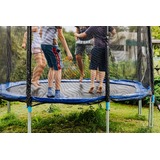Why Trampoline Nets Sag and How to Fix Them Properly
Author: Jump Star Trampolines Date Posted:21 July 2025

Trampoline nets are a key safety feature that help ensure everyone, especially kids, stay on the trampoline during those exciting jumps and flips. But if you've noticed your trampoline net starting to sag, you're not alone. Many families in Perth experience this issue due to the unique challenges that their weather conditions present. The sun, rain, and wind can all contribute to the net losing its tightness over time. Understanding why this sagging occurs can help you keep your trampoline safe and enjoyable all year round.
Maintaining a tight and secure trampoline net is important not just for safety, but also for extending the life of your trampoline. A sagging net can be a sign that something is amiss, and it's crucial to address it before it becomes a bigger problem. In Perth, where the weather can swing from one extreme to the other, trampoline maintenance takes on an added layer of importance. Let's explore the common reasons why trampoline nets might sag and how you can identify the problem early on.
Common Reasons Why Trampoline Nets Sag
There are several reasons why trampoline nets might start to sag, and identifying these can help you understand how to prevent it in the future.
- Overuse and Wear and Tear: Just like any other piece of equipment, trampolines are subject to regular wear and tear. Excessive bouncing and heavy usage can stretch the netting, causing it to lose its elasticity and sag over time.
- Weather Exposure: In Perth, the varied weather conditions can take a toll on outdoor equipment. Long periods of sun exposure can weaken the net's fibers, while rain and wind can further stress the material. Protecting your trampoline from the elements can help maintain the net's firmness.
- Poor Installation Practices: If the net wasn't attached tightly during the initial setup, it's more likely to sag prematurely. It's important to follow the manufacturer's installation guidelines closely to ensure a snug fit from the start.
- Low-Quality Materials: Using a trampoline with a net made of subpar materials may seem like a cost-effective choice upfront, but it often leads to a sagging net that can't withstand regular use and the elements.
By addressing these common causes, you can keep your trampoline net in top condition and ensure a safe play environment for your family. This foundational knowledge is essential for maintaining your trampoline and enjoying it to the fullest.
How to Identify a Sagging Trampoline Net
Spotting a sagging trampoline net before it becomes a safety risk is crucial. The signs are usually easy to detect if you know what to look for.
- Visual Signs of Sagging: When you look at the trampoline, the net should be taut and upright. A sagging net will have visible dips and lack the firm feel it had when newly installed.
- Changes in Net Tension: Check how the net feels when you press on it. A loss of tension can often be felt, making it easier to wiggle or pull away from the frame.
- Impact on Safety and Performance: A sagging net not only compromises safety by failing to hold jumpers in effectively but also affects performance. A loose net can distract users and reduce the fun, as it doesn't rebound as well.
Monitoring these aspects regularly can help you address issues before they escalate, ensuring that your trampoline stays safe for everyone using it.
Steps to Fix a Sagging Trampoline Net Properly
Once you've identified a sagging net, taking action is the next step. Here’s a quick guide to fixing it:
1. Inspect the Net and Frame: Begin by examining all parts of the net and its connection to the frame. Look for broken ties, loose threads, or damaged areas.
2. Adjust or Replace the Net Tension: Tightening loose areas is often enough to restore the net’s firmness. If that doesn't work, replacing sagged or stretched sections with new ones might be necessary.
3. Reinforce or Replace Hooks and Ties: Check the hooks and ties that attach the net to the trampoline. Reinforce weak spots to prevent future sagging, and replace any parts that are worn out.
4. Consider Trampoline Nets Replacement: Sometimes, the best solution is a new net. Consider a full replacement, especially if the net has deteriorated substantially over time.
Preventive Measures to Avoid Future Sagging
Taking preventive measures can reduce the chances of nets sagging again.
- Regular Maintenance Tips: Check your trampoline's net frequently, especially after heavy use or severe weather. Keeping a maintenance schedule helps spot potential issues early.
- Using Weatherproof Covers: Covering the trampoline when not in use shields it from harsh weather, prolonging the life of both frame and net.
- Proper Net Installation Techniques: Ensure the net is installed correctly from the start, following all guidelines for a snug fit. Improper installation often leads to early sagging.
By incorporating these habits, you can extend the lifespan of your trampoline net, providing a safer and longer-lasting play experience.
Enjoying a Safe and Functional Trampoline
A trampoline with a secure, well-maintained net is a joy to use. It not only enhances safety but also the quality of the jumping experience. Families can enjoy countless hours of fun without the worry of safety breaches. By keeping on top of maintenance tasks and addressing issues promptly, your trampoline will remain a highlight in your backyard activities for years.
Checking the net regularly and responding quickly to any signs of wear keeps the fun going without a hitch. Keep this guide handy for a quick reference whenever you need to give your trampoline a little TLC.
Keep your trampoline safe and fun for years by staying on top of maintenance. If you are noticing that the net is no longer as secure as it should be, it might be time to look into trampoline nets replacement. Jump Star Trampolines offers a wide selection to help you get your trampoline back to its best. Give your trampoline the care it needs and enjoy endless hours of safe jumping with your family.






